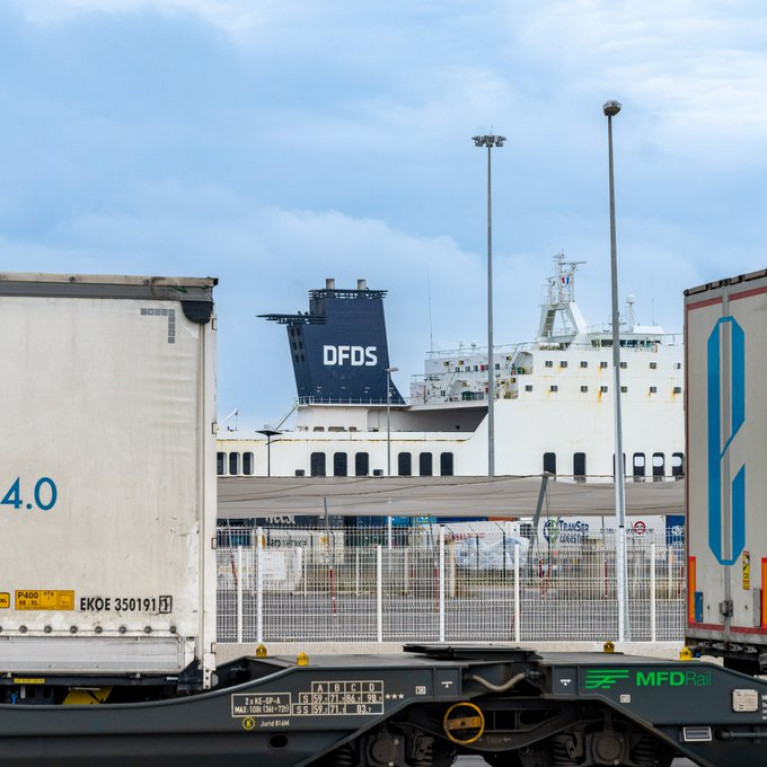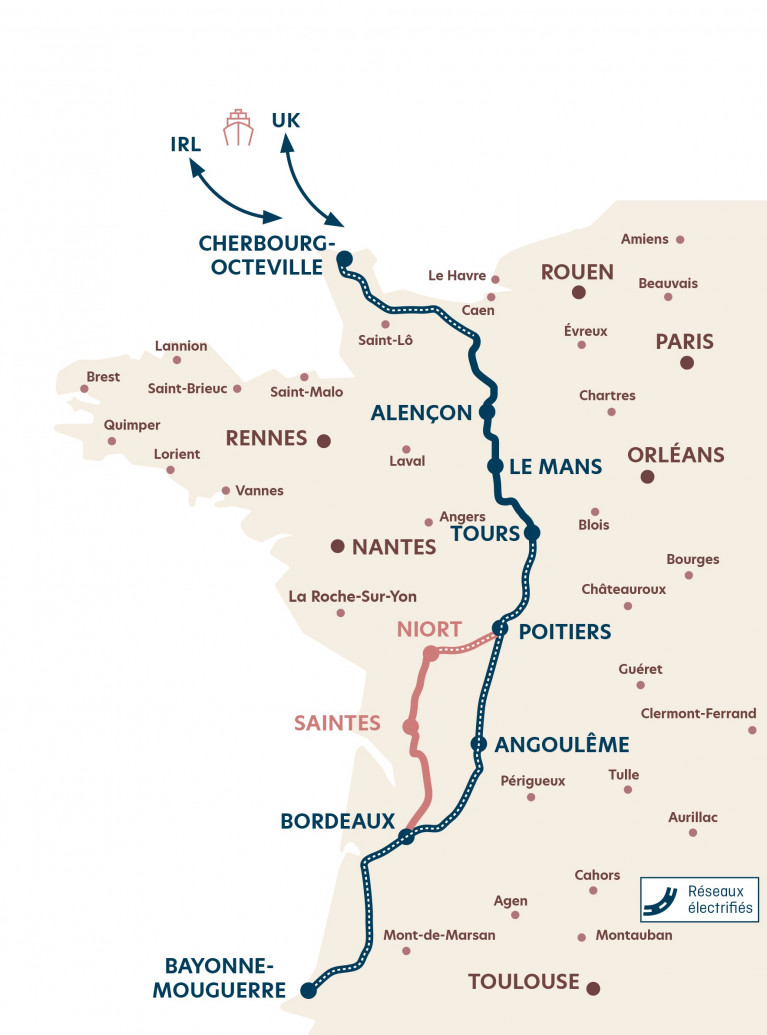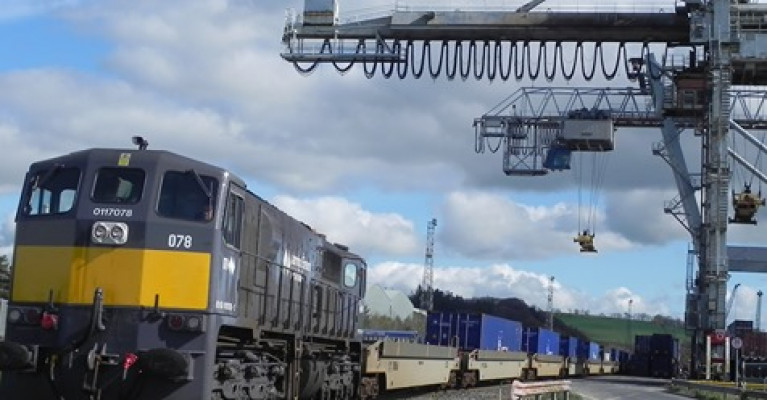Displaying items by tag: New railfreight
DFDS Introduce New Rail Freight Service from Calais to Séte on Mediterranean Sea to Link Turkey
DFDS the operator of the Rosslare Europort-Dunkirk freight ferry route, has announced that they are introducing a new rail freight service from Calais to Séte which starts today.
The new rail service connects London with Yalova in Turkey, will shorten transport time between London and Istanbul.
The new line means that DFDS will be able to offer a full complement of rail and sea transport between London and Istanbul, with a transit time of just 7 days, making it the fastest route there is between the UK and Turkey.
The new route expands DFDS’s existing network of services between the UK and Europe and comes in response to growing demand.
Lars Hoffmann, Head of DFDS’s Mediterranean Business Unit said: “We’re delighted to be adding a new rail line service to improve connections and shorten transport time between the UK and Turkey.
“It aligns with our business strategy to grow and expand the extensive route network that DFDS already offers, helping our customers, communities – and our own business of course – to grow.
“By combining our ferry activities in the Mediterranean and the UK with a new rail service, we’re able to offer by far the fastest connection between London and Istanbul. It’s a sign of confidence in the popularity of our offerings and a strong indication of our commitment to our customers.”
The service will run twice a week, with two weekly departures in each direction between Calais and Séte.
This is the latest in a series of investments that DFDS is making to improve its service; as an unaccompanied freight service from Sheerness to Calais was opened last year. The route can carry over 100 trailers or containers per sailing.
Since the launch of the UK-France route, Afloat adds London Medway port reported a record month in trading unccompanied trailer-units.
Brittany Ferries Gives Green Light to Port of Cherbourg-Bayonne, South-West France Rail-Freight Link
Brittany Ferries has given the go-ahead to a new rail-freight link connecting the Port of Cherbourg in Normandy and Bayonne in the Nouvelle Aquitaine region in south-western France.
The Breton based ferry company first announced the rail project back in February 2020, shortly before the COVID-19 health crisis hit, forcing a reduction in ferry services for nearly two years. But while the project—which Brittany Ferries deems strategic—was delayed, it was never cancelled.
During the pause, Brittany Ferries worked with French rail network operator SNCF Réseau and the Ministry for Ecological Transition to determine the routing for the new service, which will provide daily return journeys between Cherbourg and Mouguerre. Following a study into the modification of four railway tunnels on the Atlantic corridor route to allow the lowest available wagons to pass through, a framework agreement was signed, allowing the project to enter its concrete development phase.
With support from the French-state, Europe, and the regions of Normandie and Nouvelle Aquitaine, Brittany Ferries will open the ‘rail motorway’ linking the port of Cherbourg to the European Freight Centre at Mouguerre, near Bayonne, thereby connecting Spain to the UK and Ireland via the French railway network.
The launch of the new service, initially planned for 2022, is now expected by mid-2024.
Minimising transport’s environmental impact
To meet the needs of hauliers and logistics companies who wish to reduce harmful emissions and greenhouse gases, Brittany Ferries will diversify its freight offer, by offering a combined transport service for unaccompanied trailers along the French Atlantic Coast. The new link will form a natural extension of Brittany Ferries’ existing sea routes linking Cherbourg to Ireland and the UK, cutting the number of lorries transiting France by road by around 25,000 per year. Brittany Ferries will operate and sell the new service, effectively becoming a rail operator.
The next steps
Planning for rail movements using the French rail network is now underway.
The next phase will comprise the construction of two rail freight terminals in Cherbourg and Mouguerre, and the acquisition of wagons and specialised loading equipment for the Lohr Railway System which has been selected for the project.
Ports de Normandie, in its capacity as an investor, and the Port of Cherbourg in its capacity as a future operator, are also involved in planning for the next phase of the project. The first step is to organise a preliminary consultation with the residents of Cherbourg. The Normandy part of the project has received the support of Europe, the Normandy Regional Council, the Manche department, and the Communauté d’agglomération du Cotentin.
Brittany Ferries meanwhile will work closely with the Communauté d’agglomération du Pays Basque (CAPB) and the Nouvelle-Aquitaine region to carry out public consultation in Bayonne. The company has initiated discussions with the CAPB in order to acquire land for the Mouguerre rail freight terminal. In addition, a consortium comprising Mouguerre transport operators, the CAPB and Brittany Ferries has been formed to respond to a European Union call for proposals under the Connecting Europe Facility, which aims to develop new multimodal platforms.
Main characteristics of the ‘rail motorway’
- A rail service with sea connections linking Poole, Portsmouth and Rosslare (Europort) to Cherbourg, allowing seamless transport of unaccompanied trailers from Ireland and UK to the Iberian Peninsula and vice versa.
- A 970km rail journey replacing a 920km road journey
- A regular year-round service, with one daily return journey, six to seven days per week, operated by two trains:
- Each train is composed of 21 MODALOHR UIC wagons with double pockets, allowing 42 trailers to be transported. Trailers are rolled on and off using specialised horizontal handling equipment.
- Parts of the route are not currently electrified. Initially the trains will be hauled by diesel locomotives, but in the future these could be replaced by dual-mode locomotives, further reducing emissions.
- From 2024 trains will be routed via Saintes, then from 2026 via the Poitiers-Angoulême-Bordeaux mainline.
- High service reliability and punctuality will foster customer loyalty.
- Journeys have been timetabled to connect with ferry arrival and departure times, whilst also avoiding periods of peak road traffic in Cherbourg.
The southbound service will depart Cherbourg at 19:15, arriving in Bayonne/Mouguerre the following day at 11:00. The northbound service will depart Bayonne/Mouguerre at 19:26, arriving at Cherbourg the following day at 11:08.
The service will be available to customers of all Cherbourg ferry operators, as well as logistics companies based in the wider Cherbourg area.
Modalohr railway wagons for sustainable transport
Founded over 50 years ago, the Alsace-based LOHR group offers its customers transport systems that meet the needs of an increasingly environmentally-aware transport sector.
Modalohr wagons combined with fixed equipment at terminals allow rapid and secure loading and unloading of semitrailers. Since 2003 this French technology has allowed more than two million trucks to be shifted from European roads to railways, cutting carbon dioxide emissions by more than 2 million tonnes. Each time a semitrailer is transported over 1000km by rail instead of road, negative externalities such as accidents, noise, congestion and emissions are reduced by €800.
New Iarnród Éireann and XPO Freight Service Begins Between Port of Waterford and Ballina
At the Port of Waterford today, Iarnród Eireann and XPO Logistics, a leading global provider of freight transportation solutions, launched a new rail freight service in each direction between the south-east port and Ballina, Co Mayo.
The new rail service begins weekly operations today, building to twice-weekly within eight weeks.
It will offer Irish industry a greener and more efficient mode of transporting freight between the West and southeast of the country. In addition the service sees the potential for over 5,000 truck movements a year to switch from road to rail, with a resulting reduction in road congestion, and 75% reduction in emissions per unit.
The new service comes as Iarnród Éireann is finalising a new national rail freight strategy to identify growth and investment opportunities to significantly grow rail freight operations.
Port of Waterford Chief Executive Frank Ronan said, “Port of Waterford welcomes the re-introduction of rail freight services to the Port at Belview. These trains, carrying container freight, will work very effectively with the Port's Lo-Lo shipping services to provide businesses in Ireland's West/North West with a compelling logistics solution to and from mainland Europe.
Minister for Transport, Eamon Ryan TD, welcomed the new service, saying: “The rail network has a critical role to play in transforming how we transport people and goods with a view to achieving net-zero emissions. This service offers a practical and sustainable option for businesses on both sides of the country who are looking to move goods for domestic and export markets. As we examine the potential to increase the use of the network for freight, it is fitting that this new service will offer an immediate solution for freight movement between these key locations.”
Minister of State for Transport & Logistics, Hildegarde Naughton TD said: “Ireland’s freight, logistics and distribution transport sector plays a critical role in our economy and this new service will sustainably connect businesses in the West of Ireland to the Port of Waterford and onwards to export markets. Our supply chains are resilient and by adding new rail transport offerings to industry, we can continue to support local communities and in turn, our climate objectives.”
Iarnród Éireann Chief Executive Jim Meade said, "We are entering a very exciting phase where rail freight can offer key solutions for the movement of freight as the country addresses both environmental and congestion challenges in this sector. We are currently finalising a very ambitious strategic plan for the growth of rail freight between key locations across the country. Today's announcement with XPO and Waterford Port demonstrates the viable opportunities that can be developed that will not just support industry and the logistics sector, but is also fully aligned with the country's climate action plan."
Dan Myers, managing director, transport – UK and Ireland, XPO Logistics said, “Climate change is a critical global challenge; the solutions will take a concerted effort, coordinated action and cooperation. Our collaborative, end-to-end service with Irish Rail — where XPO provides the booking of rail freight movements, drayage trucking of containers, and services such as cross-docking — is a double win. Our customers have new, eco-friendly transport options, and our planet wins as supply chains become greener. It’s another step in our collective journey to a carbon-neutral future.”
He added "Dublin's carbon emissions reductions and road and port congestion alleviation make this a worthwhile initiative. We wish XPO Logistics every success with this venture and look forward to working with them."
Iarnród Éireann is continuing to work with existing and potential new customers and Freight Forwarders, Ports and the Irish Exporters Association to identify opportunities and trends for rail freight development within the Irish and European market.
The new rail freight service between Ballina and Waterford is in addition to existing rail freight operations, which include:
- Container traffic from Ballina to Dublin Port
- Pulpwood from Ballina and Westport to Waterford Port
- Zinc ore from Tara Mines in Navan to Dublin Port































































